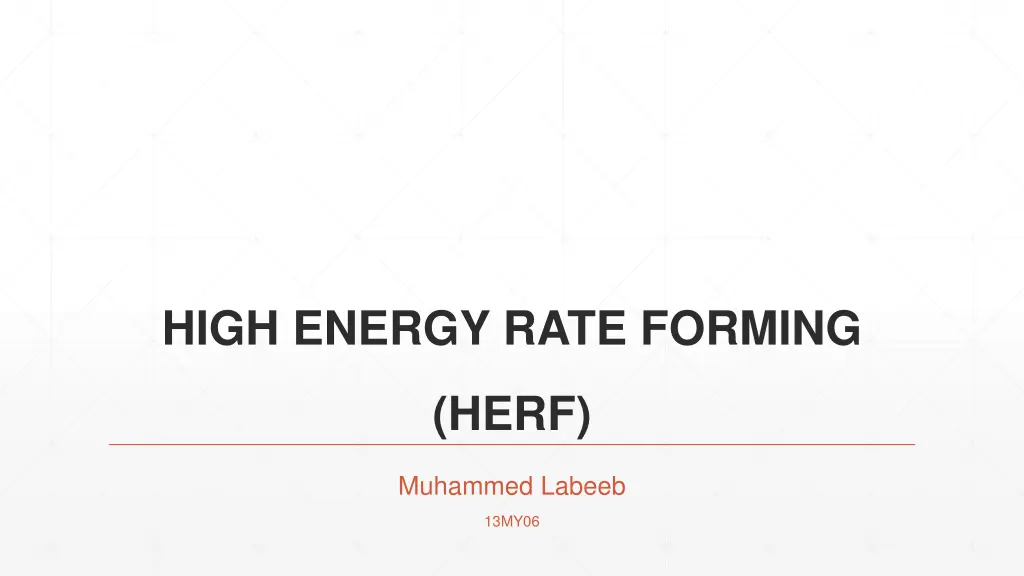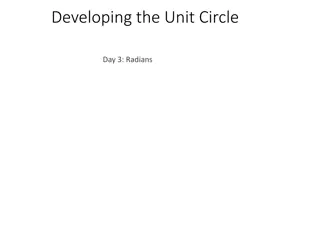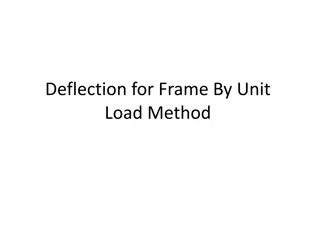
High Energy Rate Forming (HERF) and Its Applications in Rapid Metal Forming
Learn about High Energy Rate Forming (HERF) processes like explosive forming, electromagnetic forming, and electro-hydraulic forming that apply large amounts of energy in short durations to deform metals rapidly. Discover the need for HERF, types of explosive forming techniques, and the materials suitable for high strain rates. Find out how HERF is used for forming difficult materials like Titanium and Tungsten alloys.
Download Presentation

Please find below an Image/Link to download the presentation.
The content on the website is provided AS IS for your information and personal use only. It may not be sold, licensed, or shared on other websites without obtaining consent from the author. If you encounter any issues during the download, it is possible that the publisher has removed the file from their server.
You are allowed to download the files provided on this website for personal or commercial use, subject to the condition that they are used lawfully. All files are the property of their respective owners.
The content on the website is provided AS IS for your information and personal use only. It may not be sold, licensed, or shared on other websites without obtaining consent from the author.
E N D
Presentation Transcript
HIGH ENERGY RATE FORMING (HERF) Muhammed Labeeb 13MY06
INTRODUCTION Many metals tend to deform more readily under extra fast application of load In these forming processes large amount of energy is applied for a very short interval of time The parts are formed at a rapid rate, and thus these processes are also called high velocity forming (HVF) processes (typically 20-300 m/s) Since the forming of the metal occurs so quickly, desirable materials for (HERF) will be ductile at high deformation speeds
NEED FOR HERF The forming processes are affected by the strain rates (or deformation velocity) used, They are The flow stress increases with strain rates The temperature of workpiece is increased due to adiabatic heating Improved lubrication, if lubricating film is maintained as strain rate increases Thus many difficult to form materials like Titanium and Tungsten alloys, can be deformed under high strain rates There are three main high energy rate forming processes: explosive forming, electromagnetic forming, and electro hydraulic forming
EXPLOSIVE FORMING A punch in conventional forming is replaced by an explosive charge Explosives used can be: High energy chemicals like TNT, RDX, and Dynamite. Gaseous mixtures Propellants Size of work piece, Geometry of deformation and Safety considerations are to be made. Types of explosive forming: 1) Unconfined type or Stand off technique 2) Confined type or Contact technique
EXPLOSIVE FORMING Unconfined type or Stand off technique The work is firmly supported on the die and the die cavity is evacuated. A definite quantity of explosive is placed suitably in water medium at a definite stand off distance from the work. On detonation of the explosive charge, a pressure pulse (or a shock wave) of very high intensity is produced Role of water: Acts as energy transfer medium Ensures uniform transmission of energy Muffles the sound of explosion Cushioning/ smooth application of energy on the work without direct contact
EXPLOSIVE FORMING Unconfined type or Stand off technique
EXPLOSIVE FORMING Confined type or Contact technique The pressure pulse or shock wave produced is in direct contact with the work piece (usually tubular) and hence the energy is directly applied on the work without any water medium. The tube collapses into the die cavity and is formed. It is used for bulging and flaring operations Advantages: Entire shock wave front is utilized as there is no loss in water. More efficient as compared to unconfined type.
EXPLOSIVE FORMING Confined type or Contact technique
ELECTROMAGNETIC FORMING Electromagnetic forming is a process that uses a magnetic surge to form a sheet metal part The electrical energy stored in a capacitor bank is used to produce opposing magnetic fields around a tubular work piece, surrounded by current carrying coils The coil is firmly held and hence the work piece collapses into the die cavity due to magnetic repelling force, thus assuming die shape Suitable for small tubes Operations like collapsing, bending and crimping can be easily done. Electrical energy applied can be precisely controlled and hence the process is accurately Controlled The process is safer compared to explosive forming.
ELECTRO HYDRAULIC FORMING A sudden electrical discharge in the form of sparks is produced between electrodes and this discharge produces a shock wave in the water medium. This shock wave deforms the work plate and collapses it into the die The characteristics of this process are similar to those of explosive forming. The major difference, however, is that a chemical explosive is replaced by a capacitor bank, which stores the electrical energy Better control of the pressure pulse as source of energy is electrical- which can be easily controlled. Safer in handling than the explosive materials. More suitable if the work size is small to medium. Thin plates can be formed with smaller amounts of energy
ADVANTAGES OF HERF Production rates are higher, as parts are made at a rapid rate. Die costs are relatively lower. Tolerances can be easily maintained. Versatility of the process it is possible to form most metals including difficult to form metals. No or minimum spring back effect on the material after the process. Production cost is low as power hammer (or press) is eliminated in the process. Hence it is economically justifiable. Complex shapes / profiles can be made much easily, as compared to conventional forming. The required final shape/ dimensions are obtained in one stroke (or step), thus eliminating intermediate forming steps and pre forming dies. Suitable for a range of production volume such as small numbers, batches or mass production
LIMITATIONS OF HERF Highly skilled personnel are required from design to execution. Transient stresses of high magnitude are applied on the work. Not suitable to highly brittle materials Source of energy (chemical explosive or electrical) must be handled carefully. Governmental regulations/ procedures / safety norms must be followed. Dies need to be much bigger to withstand high energy rates and shocks and to prevent cracking. Controlling the application of energy is critical as it may crack the die or work. It is very essential to know the behaviour or established performance of the work metal initially
REFERENCES George E. Dieter, Mechanical Metallurgy, Mcgraw Hills, 1988 http://nptel.ac.in/courses/Webcourse-contents/IIT- ROORKEE/MANUFACTURING- PROCESSES/Metal%20Forming%20&%20Powder%20metallurgy/lecture9/lectur e9.htm http://nptel.ac.in/courses/112107145/12 http://thelibraryofmanufacturing.com/high_energy_rate_forming.html






















